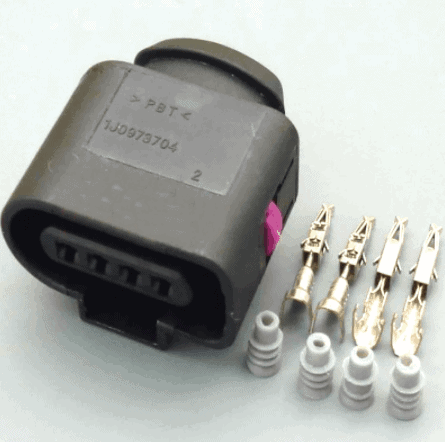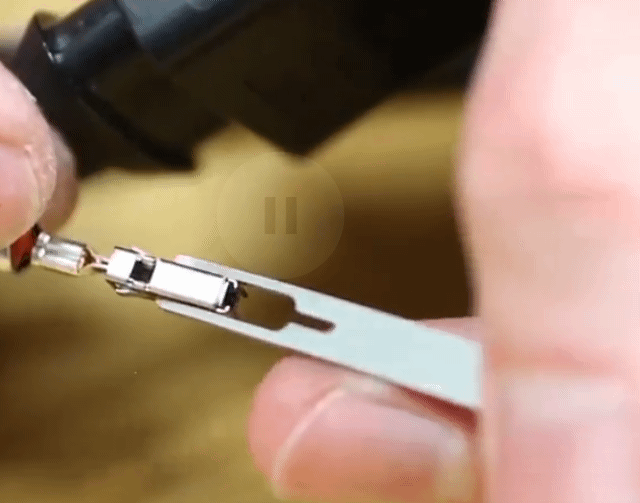Subjects:
- Preface
- Wire gauges
- Specific resistance of the wire
- Plug connections
- wire repair
- Unlock Plugs
Preface:
Modern vehicles are equipped with a lot of electronics. They often contain dozens of ECUs, each responsible for specific functions.
- Engine compartment: ECU for the engine electronics, automatic transmission, ABS/ESP;
- Interior: ECU for the airbags, in doors, under the seats, in the roof for the sliding roof or lighting, in the trunk for the tow bar electronics, etc.
These ECUs and actuators receive their power directly from the fuse box. Since there are multiple power wires and fuses, we can often find multiple fuse boxes, such as in the engine compartment, dashboard and even in the trunk of passenger cars.
Power wires (positive) run from the fuse box to various components, such as ECUs and actuators. The ECUs receive information from sensors via signal wires.
An example in the interior is the door switch, which indicates 12 or 0 volts respectively when open or closed. In the engine compartment, the coolant temperature sensor can send a 20 volt signal to the ECU at a temperature of 2,5 degrees Celsius and a 90 volt signal at 0,5 degrees Celsius.
The ECU then controls the actuator, supplying power to a passive actuator (e.g. an injector), sending a voltage signal to an active actuator (COP ignition coil), or sending a digital message to an intelligent actuator (wiper motor). Each ECU and actuator is connected to a ground point on the vehicle body or chassis via one or more ground wires.
All the positive, ground, signal and communication wires between the fuse boxes, ECUs, sensors, actuators and ground points create a huge amount of wiring. Manufacturers run wiring as one bundle through the vehicle as much as possible. We call this a wiring harness.
In the next image we see part of the wiring harness with dozens of wires running through it. The wiring harness is wrapped with tape to hold the wiring together. The colors are still visible between the turns of the tape, because a technician can easily find the wire color when looking for faults.
A wiring harness has many branches: the wiring harness runs from the engine compartment to the trunk, but also from the left to the right doors, under the dashboard from left to right and under the seats. The wiring harness is made precisely to fit the vehicle.
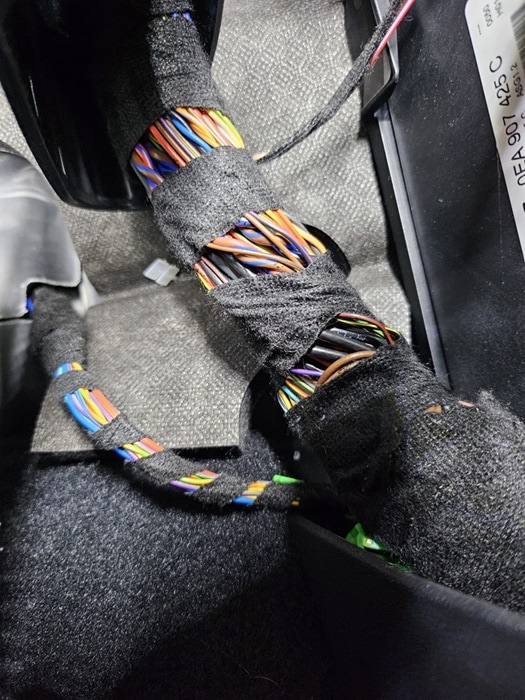
A wire in a wiring harness can become damaged. If the insulation has often been damaged by repeated bending (for example, on a door hinge or tailgate) or if the wire has rubbed against something, the wire can in most cases be repaired. The damaged part is removed, and a new piece of wire is soldered in between and then sealed with heat shrink tubing. However, when there are short circuits and burnt wires, things become more complicated. In that case, especially for a car with a high current value, it may be decided to install a new wiring harness.
Wire thicknesses:
In the car we find many different wire thicknesses. In the engine compartment we find thin wires from sensors and relatively thick wires to actuators. In the following diagram we see a black (ground) wire on the battery (A) of 25,0 mm². This is the thickest wire we find in the engine compartment. On the dynamo (C) we see a black wire of 16,0 mm² on the B+. On the control unit J367 we find considerably thinner wires from 0,35 to 0,5 mm².
The choice of wire thickness has to do with the maximum current and the length of the wire in relation to the specific resistance of the wire:
- A thick wire is suitable for higher current strengths;
- The longer the wire is, the higher the resistance of the wire becomes. Long wires are therefore often thicker.
A minus and B+ cable of the dynamo must conduct a high current. A thin wire would have too high an internal resistance, which would cause a temperature increase in addition to voltage loss. A small current flows through the wires to the ECU.
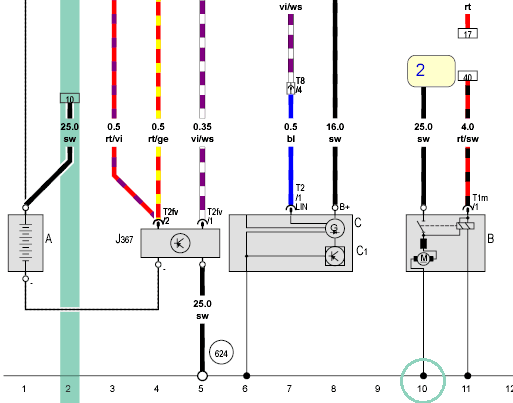
The resistance in the wire has a great effect on the voltage drop. The current plays a major role in this. To make this clear, two calculations follow below. In both examples, the resistance of the wire is 0,1 Ω.
We take a positive wire from a 21 Watt lamp and calculate the current by dividing the power by the source voltage of 12 volts (the power law). Depending on the temperature, the current is around 1,75 A. Using Ohm's Law we calculate the voltage drop across a wire.

The voltage drop of 0,18 volts is permissible, as the lamp burns at a voltage of (12 – 0,18) 11,82 volts. To be clear, the 0,18 is the V3 in the V4 measurement. The resistance in this wire is therefore low enough not to have a negative influence on the operation of the consumer.
In the following example we will take the positive wire from the starter motor. Again the resistance of the plus wire is 0,1 . The measured starting current is 90 Amps.
The resistance in the wire causes a voltage drop of 9 volts. At a voltage of 12 volts with the starter motor engaged, only 3 volts will remain to operate the starter motor. This is obviously too little; the starter motor will not or hardly start to move.
Conclusion: a resistance of 0,1 Ω in a positive wire has hardly any consequences for a lamp, but is so high for a starter motor that it no longer functions.
Specific resistance of the wire:
Each wire has an ohmic resistance. The resistance value depends on:
- the material;
- the dimensions (length and diameter);
- temperature.
The following figure shows four wires of the same material, with wire A having the highest resistance and wire D having the smallest resistance.
- In proportion, 2L is twice as long as XNUMX;
- In proportion, 2d is twice as long as d.
A thick, short wire has less resistance than a thin long wire.
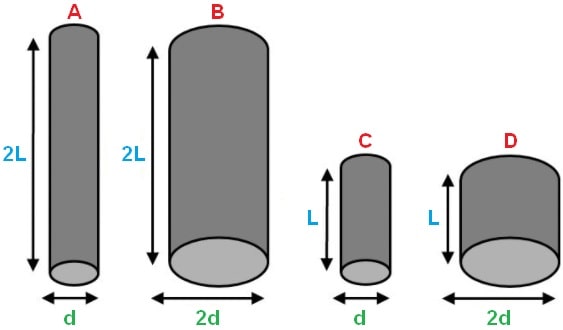
The resistance of a wire can be calculated with the following formula:
Herein is:
- R is the resistance of the wire in ohms [Ω];
- l the length of the wire in meters [m]
- ρ (rho) the resistivity of the wire in ohmmeters [Ωm]
- A is the cross-sectional area of the wire in square meters [m²]
The formula shows that the resistance of the wire increases with a greater length (l), and decreases with a greater cross-section (A). The resistivity of a wire is expressed in ohm-meters (Ωm). Because we are dealing with small numerical values, we use a 10^6 times smaller unit, which is micro-ohm-meter (µΩm).
Example:
We calculate the resistance of a copper wire with a length of 2 meters and a cross section of 1,25 mm² and a resistivity of 0,0175 * 10^-6 m.
Plug connections:
In the car, wires are connected to a sensor, actuator or a control unit by means of a plug connection. It is also possible that somewhere in a cable harness there is a plug with which two cable harnesses can be connected to each other.
The following image shows part of a schematic of a Ford Fiesta. Here we see the component code B31 (air mass meter) and Y34 (carbon filter solenoid valve). The air mass meter is a sensor and the solenoid valve is an actuator. They are both connected to the engine control unit (top).
On the air mass meter we see a 5-pin plug (5p) with four occupied positions: 2 to 5.
The solenoid valve is fitted with a two-pin plug (2P).
The numbers on the plug in the diagram are actually shown on the plug itself. In this way one can compare the wire colors, or when the same wire color is used in several positions, the wire functions can be distinguished from each other (plus, ground, signal, etc).
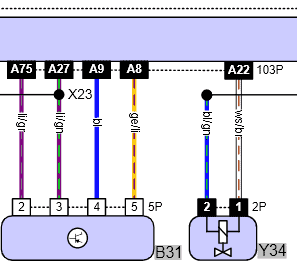
Draad repair:
A wire repair may require a new plug to be pinched on the wire. We do this with a cable torque wrench, also called crimping tool. In this example, uninsulated metal plugs are pinched onto the wire and snapped into plastic power strips.
The cable torque wrench contains a mechanism whereby a large moment can be exerted on the cable shoe or metal plug with a minimal force in the handle. Usually there is also a holding mechanism, so that the pliers "click" during squeezing and when the handle is released, it holds the cable shoe. Only when the pliers has been squeezed in its extreme position, or when the release mechanism is actuated, will the pliers release the cable shoe again.
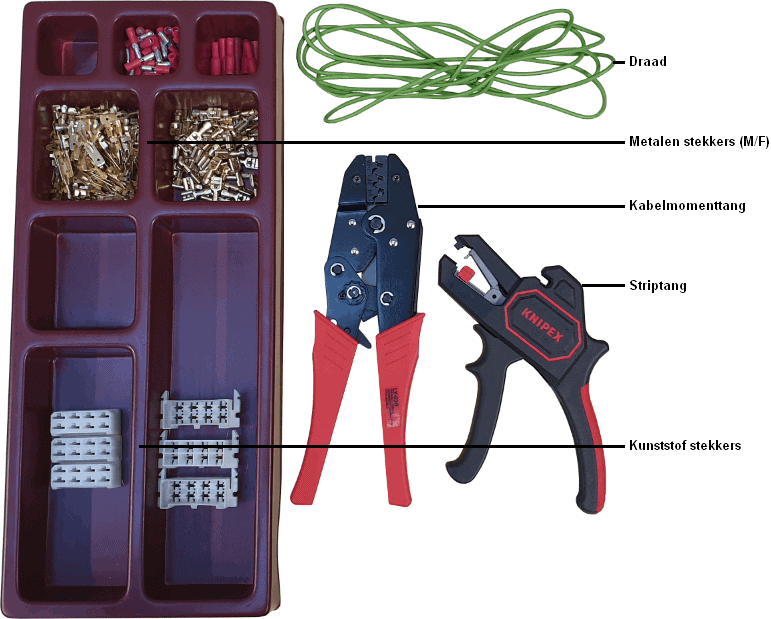
Determine the length of the wire and cut a section. Keep in mind that some of the insulation is still removed from the ends with the stripping pliers.
The two pictures below show the wire stripper and the end of the green wire:
- left: first you determine the length at which you want to strip the wire by changing the position of the red part. On the far left, as in the picture, the length is 2 mm. Squeeze the pliers. The jaws close and the metal mechanism grips the insulation. Squeeze the pliers all the way in. The insulation is slid away from the wire at the set distance;
- right: release the pliers. The copper wire is now visible.
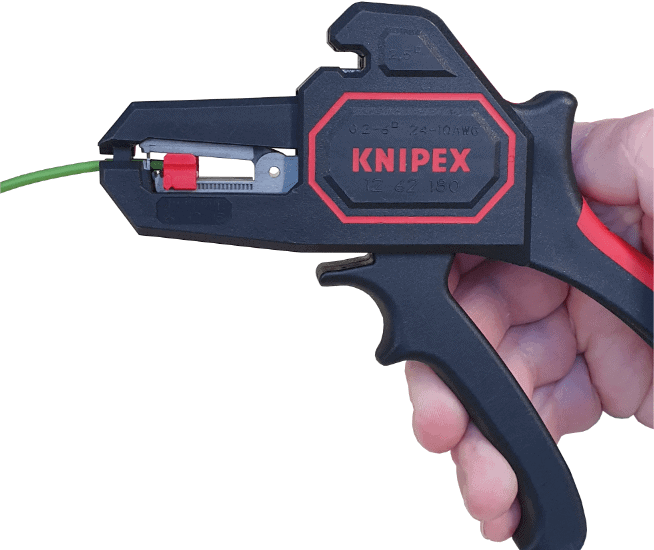
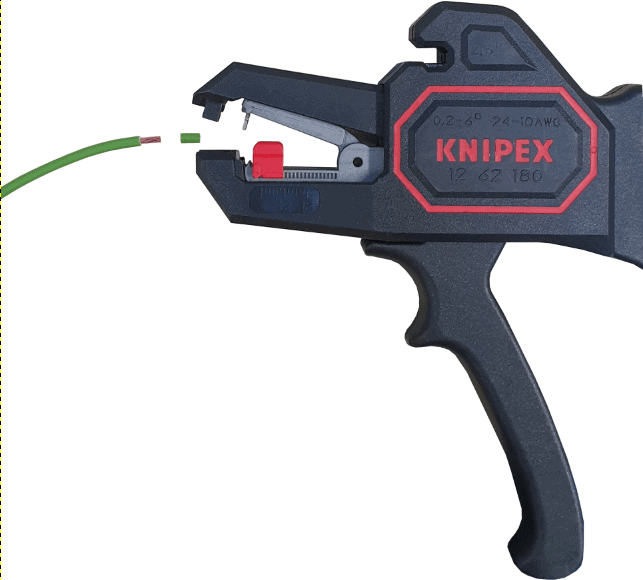
After the wire has been stripped (the copper wire is 2 mm long), cable shoes (insulated / uninsulated) or metal plugs can be pinched. The three images below show the following:
- Left: a cable torque wrench with two metal plugs (male and female);
- Middle: the metal plug is snapped into the cable torque wrench and the stripped wire is inserted into the back of the metal plug;
- Right: the other side of the cable torque wrench with the metal plug.
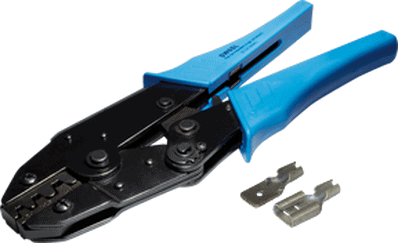
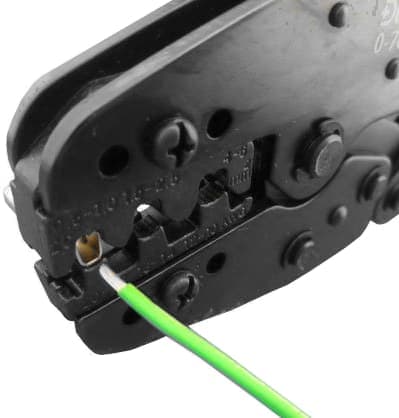
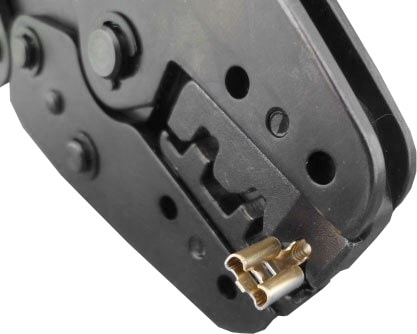
Good (1)
Sometimes mistakes are made when squeezing cable shoes. It is important to know how far one has to strip the electricity cable and how far the wire has to be pushed into the cable shoe. Here are five examples showing the three most common mistakes.
The following image shows a properly installed wire.
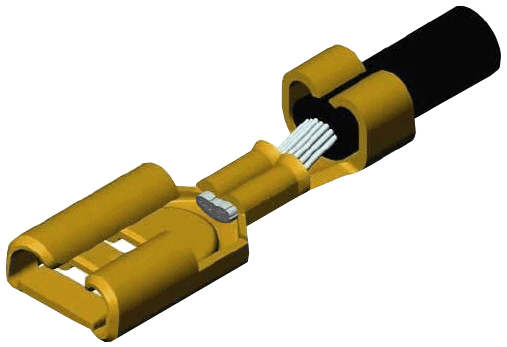
Good (2)
This is the same thread, drawn from a different angle.

Error (1)
The insulation has been stripped way too far. The copper wire protrudes and can short circuit in some plug housings after bending the ends.
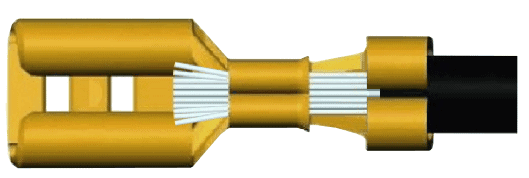
Error (2)
Not all the copper wire is pinched in the cable shoe. When bent, the protruding wire can short-circuit another wire in the plug, or against the vehicle body.
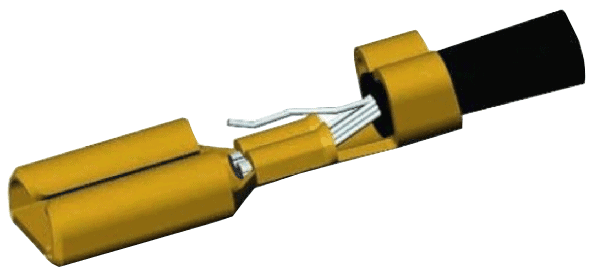
Error 3:
The insulation has been stripped too short and has been pinched in the inner part of the cable shoe. Because this part is thicker than the copper wire, the cable shoe is not completely pinched. The possible consequence of this is poor contact between the copper wire and the cable shoe.
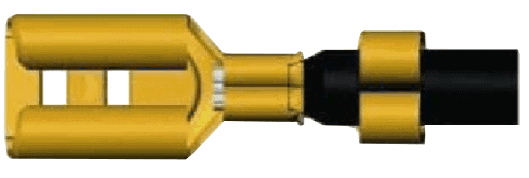
After squeezing the two metal plugs to the wire, they can be clicked into the plastic socket blocks.
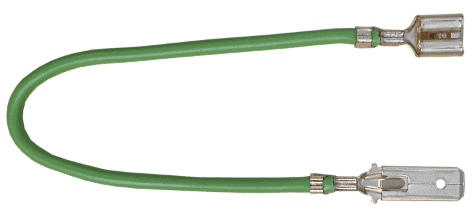
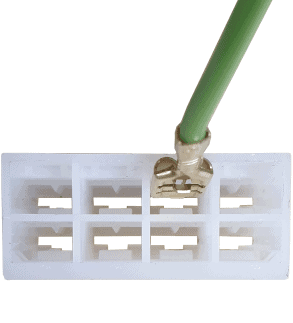
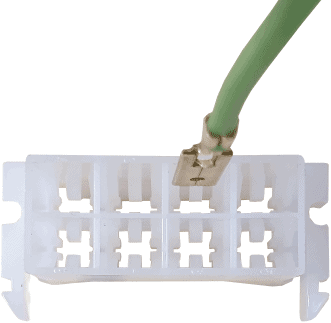

It is possible that the wire has accidentally been clicked in the wrong position. With a fitting screwdriver or a plug puller, you can carefully bend the barb on the plug and pull the wire out of the plug. Of course, the barb has to be bent back up again, because otherwise the plug will no longer click into place.
To unlock plugs:
It may be necessary to remove a wire from a plug. The metal connector pinched at the end of the wire must therefore be disassembled from the plastic connector housing. This requires a tool; a so-called plug puller. This allows you to bend the barbs on the metal connector in the plug, so that the wire can be pulled out of the plug. To be able to do this, you must first remove the lock in the plug; in the picture, the lock can be recognized by the purple plastic part, halfway through the plug. The lock prevents the wire from being pulled out of the plug even though the connector is unlocked with the tool. In the animation is the unlocking and removal of the wire from a four-pole plug applied in an Audi.
